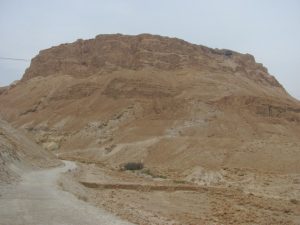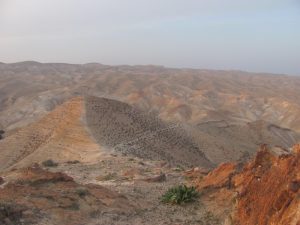DAY 9 – TUESDAY, MARCH 21:
Today would be a day spent in the Judean Desert! The day would be mostly sunny, with highs in the low-mid 70s. Perfect!
After a very nice sunrise over the Dead Sea and another hearty breakfast, we departed shortly after 8 a.m. for Masada. Located just 10-15 minutes or so north of our last night’s hotel in Ein Bokek, we ascended this 1,000 foot-high “fortress” (metzada in Hebrew, see Psalm 18:1-2) by the cable car. The story of Masada is quite amazing. Taking place between 70-73 AD, 967 Jews found refuge from the Romans here after the destruction of the Jerusalem Temple in 70 AD. Among the ruins here, we saw palaces, the casemate wall, the Roman ramp (on western side), the synagogue, and the bathhouse. A number in the group walked down the Snake Path (1.1 miles) to the bottom while others took the cable car. Masada was probably the “stronghold” to which David fled following the 1 Samuel 24 story with Saul.
About 20 minutes north is Engedi. This was our next stop. Walking back the Wadi David towards the water falls, we read from Song of Songs 1 (the “henna blossoms of Engedi”), 2 Chronicles 20 (Jehoshaphat and the ascent of Ziz), and 1 Samuel 24 (David and Saul in a cave). Many walked back to some of the waterfalls here. Water flows all year around from this spring (“Ein”).
Continuing north is the site of Qumran. This is where we ate lunch. However, over the lunch hour, some in the group hiked to Cave 1 where the first Dead Sea Scrolls were found in 1947 (this included the famous Isaiah scroll, among others). Following lunch we visited the ruins of Qumran. Here we saw cisterns, mikve (ritual baths), and the scriptorium. In front of Cave 4 (where the majority of the scrolls were found), we read from “Psalm 151” (one of a few “extra” psalms), as well as 2 Timothy 3:16 and Psalm 19. The discovery of the Dead Sea Scrolls changed not only biblical scholarship, but also lives!
Our last archaeological site was Jericho. Located just north of the Dead Sea, we climbed the tel and remembered all the stories from the Bible relating to the Jordan River to the east (Joshua 3, John 1) as well as NT Jericho located 1.5 miles south (Mark 10, Luke 19). The NT site was also where King Herod died in 4 BC. We also recalled the story of Joshua 6 relating to the OT site that was conquered by Joshua at the end of the 15th century BC. Besides an old rounded tower found here (the oldest tower in the region, perhaps 6,000 years old or more), we also saw the reventment/retaining stones that Joshua saw. It was on top of these stone walls that a mud brick wall was placed. It was this mud brick wall that came ‘tumblin’ down’ with the trumpets! At the end of the telling of the Joshua 6 story, Jeremy blew his shofar (ram’s horn) to add to the story.
From here we drove nearly 4,000 feet in elevation towards Jerusalem. On the way, we made a brief stop at Wadi Qelt where we heard Isaiah 40 read and Psalm 23 sung. The imagery of these two passages in this Judean Desert came alive!
Upon reaching our hotel in Jerusalem, we checked in and enjoyed dinner together. Many in the group then walked to the Western Wall on our “orientation walk” through the Old City. We are excited to be here in Israel’s capital!
DAY 10 – WEDNESDAY, MARCH 22: MT. OF OLIVES, POOL OF BETHESDA, VIA DOLOROSA, HERODIUM, BETHLEHEM




